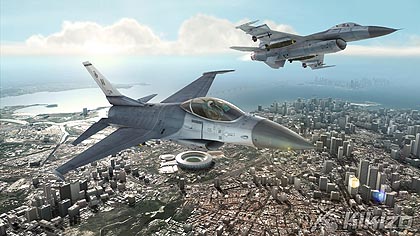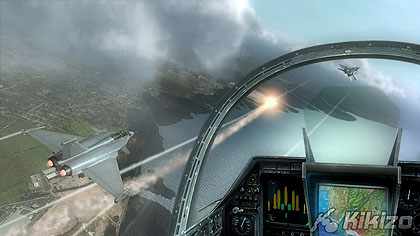Tom Clancy's HAWX: Ubisoft Interview
Let's take a closer look at HAWX in our chat with lead designer, Ubisoft Romania's Thomas Simon.

Page: 1 2
Having snapped up the entire Tom Clancy rights in March, Ubisoft is keen to diversify one of its most profitable brands. Tom Clancy's HAWX (or High Altitude Warfare eXperimental squadron) is a bit of a crucial title in this regard, taking the franchise out of dusty Mexican alleyways and hostage-strewn encampments and into the bright blue yonder. Having fiddled around with some planes (none of which we reduced to crumpled fragments, surprisingly enough), Kikizo waylaid lead designer Thomas Simon to discuss this latest attempt to slip the surly bonds of earth.
The idea of a Clancy-branded air combat sim seems a little odd at first - the franchise is best known for shadow-hugging assassins, after all, and it's hard to hug shadows when you're straddling a jet engine. Simon appreciates this, and is eager to talk precedents. "It's not at all out of the Clancy family, because you even have some Clancy novels where you see planes in action. I mean in Clear and Present Danger you have an airstrike with [Ryan and Clark] marking a target, so yeah - that's totally part of modern warfare, of modern special ops. No special ops can go without the minimum of air reconnaissance or air support. And in the game you will control that - for the first mission of the game you will replay a Ghost Recon Advanced Warfighter 2 mission from the air - the one where Captain Mitchell calls for an airstrike - you will be replaying it from the air.
"And this was not something that came by chance," Simon insists. "The team knew the names of the pilots and what they were doing and they used it that time. So it's a natural interaction."
Of course, one of the finer nuances of this particular flight simulator is its highly flexible array of player aids - known together as the "Enhanced Reality System" - which range from anti-crash mechanisms to a damage control system. Will these features amount to a dumbing-down of the genre for the sake of a broader audience? Simon doesn't think so. "The first thing to know is that this system is not designed to be left entirely on or entirely deactivated. It's designed to be used - once you've learned [the gameplay] of course - at any time. You have the switch in your hand, you can switch at any time between the two modes depending on the situation. So it's up to you to balance it.
"And we designed each mode to have its advantages and its drawbacks. Obviously the off mode is [difficult] because you're playing without the element of safety - it's a bit riskier, but it's also very efficient for a close dogfight, for multiple encounters when you have to fight several targets at the same time or dodge missiles while shooting down the guy. So it's really designed for activity and flexibility."
Flexibility seems to be the key word regardless of whether you take the namby-pamby route or fly with all the safeties off. "It's really something you learn to master," Simon goes on. "And just by playing you discover new tricks that maybe we didn't anticipate and you'll have fun with it. And that's just the dog fights, which are the base line of the game, and then you have all types of missions to complete like close air support, to escorting Ghost teams on the ground that are progressing towards the target, aerial escort missions, mid-air defence where you have to take down surface-to-air missiles... bombing situations. All kinds of missions."
While HAWX doesn't offer the same mix of air and ground-based combat as, say, Warhawk, the world below is far from a static backdrop. "ERS can help you attack a target on the ground, so you can dodge mountains while attacking and so forth," Simon explains. "So yeah, ground is going to be really a strong part of it. Today you didn't see the [Surface to Air Missile] units, for example... how they are activated, how they track you, etc."
Page: 1 2











 Satoru Iwata Video Interview - the late Nintendo president spoke with Kikizo in 2004 as 'Nintendo Revolution' loomed.
Satoru Iwata Video Interview - the late Nintendo president spoke with Kikizo in 2004 as 'Nintendo Revolution' loomed. Kaz Hirai Video Interview - the first of Kikizo's interviews with the man who went on to become global head of Sony.
Kaz Hirai Video Interview - the first of Kikizo's interviews with the man who went on to become global head of Sony. Ed Fries Video Interview - one of Xbox's founders discusses an epic journey from Excel to Xbox.
Ed Fries Video Interview - one of Xbox's founders discusses an epic journey from Excel to Xbox. Yu Suzuki, the Kikizo Interview - we spend time with one of gaming's most revered creators.
Yu Suzuki, the Kikizo Interview - we spend time with one of gaming's most revered creators. Tetris - The Making of an Icon: Alexey Pajitnov and Henk Rogers reveal the fascinating story behind Tetris
Tetris - The Making of an Icon: Alexey Pajitnov and Henk Rogers reveal the fascinating story behind Tetris Rare founders, Chris and Tim Stamper - their only interview? Genuinely 'rare' sit down with founders of the legendary studio.
Rare founders, Chris and Tim Stamper - their only interview? Genuinely 'rare' sit down with founders of the legendary studio. The History of First-Person Shooters - a retrospective, from Maze War to Modern Warfare
The History of First-Person Shooters - a retrospective, from Maze War to Modern Warfare